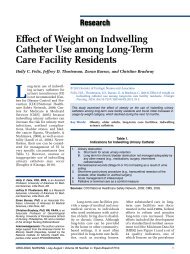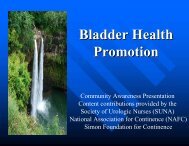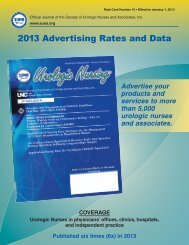Use of Sacral Neuromodulation in the Management of ... - SUNA
Use of Sacral Neuromodulation in the Management of ... - SUNA
Use of Sacral Neuromodulation in the Management of ... - SUNA
Create successful ePaper yourself
Turn your PDF publications into a flip-book with our unique Google optimized e-Paper software.
<strong>Use</strong> <strong>of</strong> <strong>Sacral</strong><br />
<strong>Neuromodulation</strong> <strong>in</strong> <strong>the</strong><br />
<strong>Management</strong> <strong>of</strong> Void<strong>in</strong>g<br />
Dysfunction<br />
Developed by <strong>the</strong><br />
<strong>SUNA</strong> <strong>Sacral</strong> Nerve Stimulation Special Interest Group<br />
Revised Oct 2010
InterStim Therapy<br />
Cumulative <strong>Use</strong> World-wide<br />
100000<br />
80000<br />
60000<br />
40000<br />
20000<br />
Technique Change – 2002<br />
Percutaneous T<strong>in</strong>ed Lead Placement<br />
0<br />
1998 2000 2002 2004 2006 2008 2010<br />
More than 85,000 patients have received InterStim Therapy
Program Goal<br />
To discuss <strong>the</strong> prevalence & treatment<br />
<strong>of</strong> ur<strong>in</strong>ary control problems and <strong>the</strong><br />
use <strong>of</strong> sacral neuromodulation as a<br />
treatment option for patients with<br />
ur<strong>in</strong>ary urgency-frequency, ur<strong>in</strong>ary<br />
urge <strong>in</strong>cont<strong>in</strong>ence and/or ur<strong>in</strong>ary<br />
retention who fail or cannot tolerate<br />
conservative treatments.
Learn<strong>in</strong>g Objectives:<br />
After complet<strong>in</strong>g this program you will be able to:<br />
• Discuss <strong>the</strong> prevalence <strong>of</strong> ur<strong>in</strong>ary urgency-frequency, ur<strong>in</strong>ary<br />
urge <strong>in</strong>cont<strong>in</strong>ence and/or ur<strong>in</strong>ary retention.<br />
• Def<strong>in</strong>e sacral nerve stimulation (SNS)<br />
• Discuss <strong>the</strong> treatment algorithm used to treat ur<strong>in</strong>ary urgencyfrequency,<br />
urge <strong>in</strong>cont<strong>in</strong>ence and retention.<br />
• Discuss <strong>the</strong> <strong>the</strong>ory <strong>of</strong> mechanism <strong>of</strong> action <strong>of</strong> sacral nerve<br />
stimulation.<br />
• Expla<strong>in</strong> <strong>the</strong> basic steps for <strong>the</strong> test stimulation and implant<br />
procedures used for InterStim Therapy<br />
• Identify <strong>the</strong> implantable and external equipment used for<br />
sacral nerve stimulation.<br />
• State <strong>the</strong> FDA approved <strong>in</strong>dications for SNS.<br />
• Identify patients appropriate for SNS when provided a case<br />
scenarios.
Void<strong>in</strong>g Dysfunction:<br />
A Hidden Problem<br />
• Patients are embarrassed to talk to healthcare providers about<br />
void<strong>in</strong>g problems<br />
• Many providers typically do not ask patients about void<strong>in</strong>g<br />
problems<br />
• Quality <strong>of</strong> life issues can <strong>in</strong>clude:<br />
Anxiety, depression, <strong>in</strong>fections,<br />
nocturia, odors, embarrassment,<br />
diet restrictions, discomfort / pa<strong>in</strong>,<br />
limitations <strong>of</strong> social activities and<br />
employment opportunities,<br />
and cost <strong>of</strong> protective garments
Normal Micturition<br />
Requires coord<strong>in</strong>ated<br />
activity between <strong>the</strong><br />
nerves and <strong>the</strong> muscles<br />
that control void<strong>in</strong>g<br />
Efferent<br />
Afferent
Fill<strong>in</strong>g Phase<br />
• Automatic Actions:<br />
– Bra<strong>in</strong> signals detrusor muscle to relax<br />
to allow ur<strong>in</strong>e to fill bladder<br />
– Once bladder fills to capacity, bladder<br />
nerves signal fullness back to bra<strong>in</strong><br />
• Conscious Actions:<br />
– As bladder fills, you become aware <strong>of</strong><br />
fullness<br />
- The response is to void or wait for a opportunity to void.
Empty<strong>in</strong>g Phase<br />
• Automatic Actions:<br />
– Void<strong>in</strong>g reflex occurs<br />
– Nerves <strong>in</strong> sp<strong>in</strong>al cord signal detrusor<br />
muscles to contract and <strong>in</strong>ternal<br />
sph<strong>in</strong>cter to relax to allow ur<strong>in</strong>e to<br />
flow from bladder <strong>in</strong>to urethra<br />
• Conscious Action:<br />
– Once ur<strong>in</strong>e enters urethra, you<br />
consciously relax <strong>the</strong> external sph<strong>in</strong>cter<br />
to allow ur<strong>in</strong>e to pass through <strong>the</strong> urethra
Abnormal Micturition<br />
Void<strong>in</strong>g dysfunction occurs when a<br />
patient’s normal micturition reflexes are<br />
altered because <strong>of</strong> a neurological<br />
disease, <strong>in</strong>fection, <strong>in</strong>flammation, or<br />
anatomical abnormalities <strong>in</strong> voluntary<br />
void<strong>in</strong>g reflexes.
Ur<strong>in</strong>ary Urgency-frequency and Ur<strong>in</strong>ary<br />
Urge Incont<strong>in</strong>ence<br />
1. Stewart WF, et al.<br />
Prevalence and burden <strong>of</strong><br />
overactive bladder <strong>in</strong> <strong>the</strong><br />
United States. World J Urol.<br />
2003:20:327-336.<br />
2. Garnett S, et al. The natural<br />
history <strong>of</strong> overactive bladder<br />
and detrusor overactivity: a<br />
review <strong>of</strong> evidence regard<strong>in</strong>g<br />
<strong>the</strong> long-term outcome <strong>of</strong> <strong>the</strong><br />
overactive bladder.<br />
J Urol. 2003;169:843.<br />
3. Haab F, et al. Persistence<br />
with antimuscar<strong>in</strong>ic<br />
<strong>the</strong>rapy <strong>in</strong> patients<br />
with overactive<br />
bladder. Int J Cl<strong>in</strong><br />
Pract. 2005;59(8):<br />
931-937. Ziment<br />
Market Research 2005.<br />
4. Medtronic Market Research<br />
1998<br />
US prevalence = 33.3 million 1<br />
7.3 million<br />
Women: 2.9 million<br />
Men: 1.1 million<br />
Women: 2.0 million<br />
Men: 0.8 million<br />
Total: 1.8 million<br />
Women: 1.3 million<br />
Men: 0.5 million<br />
16.5% <strong>of</strong> US<br />
population 1<br />
30% actively seek<strong>in</strong>g care<br />
(exclud<strong>in</strong>g men w/BPH<br />
~8.0 million) 2<br />
Patients who cannot tolerate<br />
pharmaco<strong>the</strong>rapy (~55%)<br />
4.0 million 3<br />
Patients with cont<strong>in</strong>ued symptoms<br />
actively seek<strong>in</strong>g fur<strong>the</strong>r treatment<br />
(~70%) 4<br />
2.8 million<br />
Potential patient candidates for<br />
SNS † (~65%)*<br />
Net Prevalence @ 1.8 million<br />
* Assum<strong>in</strong>g cl<strong>in</strong>ical exclusion <strong>of</strong> 20% & economic exclusion <strong>of</strong><br />
15%
Overview<br />
<strong>Sacral</strong> Nerve Stimulation (SNS)
SNS - Therapy<br />
Def<strong>in</strong>ition:<br />
An implantable system that stimulates<br />
<strong>the</strong> sacral nerves modulat<strong>in</strong>g <strong>the</strong> neural<br />
reflexes that <strong>in</strong>fluence <strong>the</strong> bladder,<br />
sph<strong>in</strong>cter, and pelvic floor.<br />
Indications:<br />
SNS is used to treat ur<strong>in</strong>ary retention<br />
and <strong>the</strong> symptoms <strong>of</strong> overactive bladder<br />
(OAB), <strong>in</strong>clud<strong>in</strong>g ur<strong>in</strong>ary urge<br />
<strong>in</strong>cont<strong>in</strong>ence and significant symptoms<br />
<strong>of</strong> urgency-frequency <strong>in</strong> patients who<br />
have failed or could not tolerate more<br />
conservative <strong>the</strong>rapies.
SNS - Therapy<br />
SNS utilizes mild electrical pulses to simulate <strong>the</strong><br />
nerves associated with void<strong>in</strong>g function.<br />
Neurostimulation may significantly improve normal<br />
void<strong>in</strong>g function.
SNS Theory <strong>of</strong> Mechanism<br />
•Urge <strong>in</strong>cont<strong>in</strong>ence:<br />
Modulation enables more<br />
normal detrusor muscle<br />
behavior<br />
•Urgency-frequency:<br />
Modulation helps reduce<br />
detrusor and pelvic floor<br />
muscle spasticity
Pharmaco<strong>the</strong>rapy vs.<br />
SNS Therapy<br />
Pharmaco<strong>the</strong>rapy:<br />
Mechanism <strong>of</strong> Action<br />
• Targets efferent effects<br />
• Poor patient compliance<br />
related to <strong>the</strong> side effects<br />
(i.e. dry mouth)<br />
SNS Therapy:<br />
Mechanism <strong>of</strong> Action<br />
•Targets afferent effects &<br />
modulation <strong>of</strong> <strong>the</strong> pelvic floor<br />
•General lack <strong>of</strong> side effects<br />
known associated with drug<br />
<strong>the</strong>rapy<br />
InterStim Therapy<br />
• Should be considered after more conservative treatment<br />
options have failed and before surgical options are considered
Cl<strong>in</strong>ical Results: 5-Year<br />
Efficacy<br />
Purpose<br />
This post-approval, non-randomized, multicenter study provided data on <strong>the</strong> longterm<br />
effects <strong>of</strong> sacral nerve stimulation for <strong>the</strong> treatment <strong>of</strong> ur<strong>in</strong>ary urge<br />
<strong>in</strong>cont<strong>in</strong>ence, ur<strong>in</strong>ary urgency-frequency, and ur<strong>in</strong>ary retention <strong>in</strong> patients who had<br />
failed or could not tolerate more conservative treatments. The study took place at<br />
17 centers <strong>in</strong> <strong>the</strong> United States, Canada, and Europe.<br />
Results<br />
The study demonstrated that InterStim Therapy can be a long-term<br />
solution for patients with overactive bladder or non-obstructive ur<strong>in</strong>ary<br />
retention. Based on <strong>the</strong> subset <strong>of</strong> study subjects for whom both basel<strong>in</strong>e and<br />
five-year data were available (i.e., <strong>the</strong> evaluable sample), improvement ranged<br />
from 39% to 78%, depend<strong>in</strong>g on <strong>the</strong> outcome assessed. If all implanted study<br />
subjects are considered (i.e., <strong>the</strong> <strong>in</strong>tent-to-treat sample) and miss<strong>in</strong>g five-year data<br />
are imputed us<strong>in</strong>g basel<strong>in</strong>e values (or, <strong>in</strong> <strong>the</strong> absence <strong>of</strong> basel<strong>in</strong>e values, from <strong>the</strong><br />
mean basel<strong>in</strong>e <strong>of</strong> all subjects with basel<strong>in</strong>e values), <strong>the</strong> results range from 28% to<br />
58%, depend<strong>in</strong>g on <strong>the</strong> outcome assessed.<br />
See InterStim Therapy Cl<strong>in</strong>ical Summary for complete details.
5-Year Cl<strong>in</strong>ical Efficacy<br />
Urge Incont<strong>in</strong>ence – 60 month post-implant results<br />
Patients %<br />
80<br />
70<br />
60<br />
50<br />
40<br />
30<br />
20<br />
10<br />
0<br />
Intent to<br />
Treat<br />
37%<br />
42%<br />
59%<br />
≥ 50% Reduction <strong>in</strong> Leaks/Day<br />
Evaluable Patients<br />
71%<br />
n = 96 n = 84 n = 61 n = 49<br />
≥ 50% Reduction <strong>in</strong> Heavy Leaks/Day 1<br />
1 Excludes patients who reported no heavy leaks at basel<strong>in</strong>e and at 60 months post-implant<br />
Intent to Treat<br />
Patients –<br />
def<strong>in</strong>ed as all<br />
implanted study<br />
subjects,<br />
<strong>in</strong>clud<strong>in</strong>g those<br />
who dropped out<br />
and were<br />
imputed as no<br />
change from<br />
basel<strong>in</strong>e.<br />
Evaluable<br />
Patients –<br />
def<strong>in</strong>ed as <strong>the</strong><br />
subset <strong>of</strong><br />
subjects for<br />
whom both<br />
basel<strong>in</strong>e and 5-<br />
year data were<br />
available.
5-Year Cl<strong>in</strong>ical Efficacy<br />
Urge Frequency – 60 month post-implant<br />
results<br />
Intent to<br />
56% 56%<br />
Treat<br />
Evaluable Patient<br />
Patients %<br />
40% 40%<br />
39%<br />
28%<br />
n = 25 n = 25 n = 25 n = 18 n = 18 n = 18<br />
≥ 50% Reduction <strong>in</strong> Voids/Day<br />
≥ 50% Increase <strong>in</strong> Volume Voided/Void<br />
≥ Improved Degree <strong>of</strong> Urgency Prior to Void
5-Year Cl<strong>in</strong>ical Efficacy<br />
Ur<strong>in</strong>ary Retention – 60 month post-implant<br />
results<br />
80<br />
Intent to<br />
70<br />
Treat<br />
Patients %<br />
60<br />
50<br />
40<br />
30<br />
20<br />
10<br />
0<br />
48%<br />
58%<br />
65%<br />
78%<br />
n = 31 n = 31<br />
n = 23 n = 23<br />
Evaluable<br />
Patient<br />
≥ 50% Reduction <strong>in</strong> Ca<strong>the</strong>terizations/Day<br />
≥ 50% Reduction <strong>in</strong> Volume/Ca<strong>the</strong>terizations
Patient Selection/Cases<br />
Factors <strong>in</strong>fluenc<strong>in</strong>g Patient<br />
Selection
Treatment Algorithm<br />
For Ur<strong>in</strong>ary Urgency-frequency<br />
and/or Ur<strong>in</strong>ary Urge Incont<strong>in</strong>ence<br />
Initial Screen<strong>in</strong>g<br />
Void<strong>in</strong>g Diary<br />
Urodynamic<br />
Workup<br />
Cont<strong>in</strong>ue as<br />
Appropriate<br />
Behavioral Techniques<br />
Interventional Techniques<br />
Medications<br />
+ -<br />
SNS<br />
Test Stimulation
Retention Treatment<br />
Algorithm<br />
Initial Screen<strong>in</strong>g<br />
Cont<strong>in</strong>ue as<br />
Appropriate<br />
Void<strong>in</strong>g Diary<br />
Urodynamic<br />
Workup<br />
Rule Out Obstruction<br />
Medications and/or<br />
Ca<strong>the</strong>terization<br />
+ -<br />
SNS<br />
Test Stimulation
O<strong>the</strong>r Issues Influenc<strong>in</strong>g<br />
Patient Selection<br />
• Mental status<br />
• Psychiatric status<br />
• Patient expectations<br />
• Multiple Sclerosis<br />
• Back or neurological problems<br />
• Support system<br />
• Discussion <strong>of</strong> alternative treatment<br />
• Issues that contribute to SNS failure
Overview<br />
1 st Phase test<strong>in</strong>g/PNE<br />
2 nd stage Implant<br />
when to program
Test & Implant Procedures<br />
• 1 st Phase: Test stimulation<br />
– Test can be done with a temporary or chronic lead<br />
2 nd stage Implant<br />
Temporary Lead<br />
Chronic Lead
Test \PNE<br />
Test stimulation:<br />
• Is done to determ<strong>in</strong>e how <strong>the</strong> patient will respond to <strong>the</strong><br />
implanted device<br />
• Is an outpatient procedure performed <strong>in</strong> <strong>the</strong> <strong>of</strong>fice or OR<br />
depend<strong>in</strong>g upon <strong>the</strong> lead used (temporary <strong>in</strong><br />
<strong>of</strong>fice/chronic <strong>in</strong> OR)<br />
• Lead is placed under <strong>the</strong> sk<strong>in</strong> through <strong>the</strong> S-3 foramen <strong>in</strong><br />
close proximity to <strong>the</strong> S-3 nerve<br />
• Lead is connected to an external device worn on belt for<br />
a period <strong>of</strong> 3-7 days<br />
• The decision for implantation <strong>of</strong> <strong>the</strong> permanent device is<br />
made based on response to <strong>the</strong> test stimulation
Void<strong>in</strong>g Diary<br />
Documentation<br />
3 days <strong>of</strong> diaries before test and dur<strong>in</strong>g test<br />
Urge Incont<strong>in</strong>ence<br />
• Number <strong>of</strong> leak<strong>in</strong>g<br />
episodes per day<br />
• Severity <strong>of</strong> leak<strong>in</strong>g<br />
episodes per day<br />
• Number <strong>of</strong> pads/diapers<br />
per day<br />
Urgency-frequency<br />
• Number <strong>of</strong> voids per day<br />
• Volume <strong>of</strong> voids per day<br />
• Degree <strong>of</strong> urgency<br />
Retention<br />
• Ca<strong>the</strong>terized volume vs voided volume<br />
• Number <strong>of</strong> ca<strong>the</strong>terizations per day vs number <strong>of</strong> voids<br />
per day
Test & Procedures<br />
2 nd stage<br />
• 2 nd Phase: Chronic Implant<br />
– If tested with temporary lead: Implantation <strong>of</strong> neurostimulator<br />
(INS) and lead and/or extension (if necessary)*<br />
– If tested with chronic lead: Implantation <strong>of</strong> neurostimulator<br />
(INS)<br />
* Components requir<strong>in</strong>g implantation<br />
depend on <strong>the</strong> selected InterStim<br />
neurostimulator used for <strong>the</strong> implant.
2 nd Stage<br />
Implant Procedure 2 nd Stage:<br />
• Outpatient procedure done <strong>in</strong><br />
operat<strong>in</strong>g room us<strong>in</strong>g general or<br />
local anes<strong>the</strong>sia<br />
• Stimulator is implanted and<br />
connected to a lead that will<br />
stimulate <strong>the</strong> sacral nerve<br />
• Stimulator is usually placed <strong>in</strong><br />
upper buttock<br />
• The entire implantable System<br />
resides under <strong>the</strong> sk<strong>in</strong><br />
• Entire procedure takes 20-30<br />
m<strong>in</strong>utes
System Implantation: Connect implanted Lead to INS<br />
• Create a subcutaneous<br />
pocket<br />
• Tunnel <strong>the</strong> implanted lead<br />
to <strong>the</strong> pocket site<br />
• The implanted lead,<br />
extension (if required), and<br />
INS are connected and<br />
placed <strong>in</strong> <strong>the</strong> pocket.<br />
• Verify system <strong>in</strong>tegrity (no<br />
short or open circuit), <strong>the</strong>n<br />
close <strong>the</strong> pocket.
Benefits <strong>of</strong> SNS<br />
Potential Adverse Events<br />
• Test stimulation period allows <strong>in</strong>formed choice for<br />
patient and doctor<br />
• Effective treatment <strong>in</strong> properly screened patients<br />
• Safe<br />
• Reversible<br />
• Does not preclude use <strong>of</strong> alternative treatments<br />
• Potential risks, pa<strong>in</strong> at neurostimulator site,<br />
<strong>in</strong>fection transient electric shock
When Do You Program?<br />
• After <strong>in</strong>itial implantable neurostimulator (INS)<br />
implantation:<br />
– Day <strong>of</strong> surgery—1 week (physician preference)<br />
• Patient’s system requires “reprogramm<strong>in</strong>g”:<br />
– Symptoms reappear<br />
–Discomfort<br />
– Loss <strong>of</strong> stimulation
Case Studies<br />
Retention with frequencyurgency
History<br />
• 65 y/o wf with retention, frequency,<br />
urgency and void<strong>in</strong>g dysfunction.<br />
Stra<strong>in</strong>s to void <strong>in</strong> addition to do<strong>in</strong>g CIC<br />
and spontaneous void<strong>in</strong>g<br />
• Leak<strong>in</strong>g <strong>in</strong> between CIC<br />
• Small cystocele noted
Void<strong>in</strong>g Diary<br />
• Pt voids 2-4 oz q 2-3 hrs<br />
• Pt caths 3 x day (ave. = 200-300cc)<br />
• Leak<strong>in</strong>g <strong>in</strong> between cath<strong>in</strong>g<br />
• Wears 3-4 pads per day
Cystoscopy<br />
• Normal urethra, bladder and ureters<br />
• Normal pelvic exam and female<br />
genitalia<br />
• No edema, lesions or palpable<br />
abnormalities<br />
• Anterior and apical compartments are<br />
well supported
Stra<strong>in</strong>s to Void
Video Urodynamics
Urodynamic Results<br />
• Normal storage parameters consist<strong>in</strong>g<br />
<strong>of</strong> nl sensation/compliance and<br />
capacity<br />
• No Detrusor overactivity<br />
• No SUI<br />
• Abnormal void<strong>in</strong>g (stra<strong>in</strong>s to void)<br />
• No evidence for outlet obstruction
Recommendations<br />
and Results<br />
• SNS Test<br />
• Voids 4-5 times a day and empty<strong>in</strong>g<br />
(cath<strong>in</strong>g less than 50cc)<br />
• No leak<strong>in</strong>g <strong>in</strong> between cath<strong>in</strong>g<br />
• Pt implanted 3 wks later
Post InterStim Implant<br />
• Do<strong>in</strong>g extremely well and empty<strong>in</strong>g<br />
with no need to perform CIC<br />
• PVR post implant <strong>in</strong> <strong>of</strong>fice 13cc<br />
• Cont<strong>in</strong>ues spontaneous void<strong>in</strong>g<br />
• Reports occasional twitch<strong>in</strong>g <strong>of</strong> her toe<br />
• F/U 1 yr or PRN-per cl<strong>in</strong>ic protocol
Patient Care <strong>Management</strong><br />
• Mention SNS to patients and family early <strong>in</strong><br />
treatment to give <strong>the</strong>m an opportunity to<br />
adjust to <strong>the</strong> idea <strong>of</strong> an implanted device give<br />
<strong>the</strong>m encouragement that <strong>the</strong>re are<br />
alternative treatments if conventional <strong>the</strong>rapy<br />
fails.<br />
• Perform thorough patient workup and correct<br />
any mixed <strong>in</strong>cont<strong>in</strong>ence issues or obstructive<br />
uropathy to give a SNS trial <strong>the</strong> best chance<br />
to succeed.
Utilization <strong>of</strong> Multiple<br />
Modalities<br />
To achieve optimal results for SNS<br />
patients may need:<br />
– to cont<strong>in</strong>ue on or go on pharmacologic<br />
<strong>the</strong>rapy<br />
– Cont<strong>in</strong>ue dietary modifications<br />
– Cont<strong>in</strong>ue or <strong>in</strong>itiate pelvic floor<br />
rehabilitation
Patient/Family Considerations<br />
• Provide realistic expectations <strong>of</strong> sacral<br />
nerve simulation so that everyone<br />
clearly understands that it is to help,<br />
not necessarily cure, <strong>the</strong>ir ur<strong>in</strong>ary<br />
problem.<br />
• Assist patients to recognize <strong>the</strong>ir role <strong>in</strong><br />
achiev<strong>in</strong>g optimal ur<strong>in</strong>ary function<strong>in</strong>g<br />
and ma<strong>in</strong>ta<strong>in</strong><strong>in</strong>g <strong>in</strong>tegrity <strong>of</strong> SNS.
<strong>Management</strong> <strong>of</strong> Care<br />
• Life choices that may affect system <strong>in</strong>tegrity<br />
and longevity<br />
• Impact on o<strong>the</strong>r chronic health problems or<br />
ur<strong>in</strong>ary status<br />
• Patients need to be counseled regard<strong>in</strong>g<br />
<strong>the</strong> <strong>in</strong>ability <strong>of</strong> hav<strong>in</strong>g MRI once <strong>the</strong> SNS is<br />
placed<br />
• Patient responsibility to cont<strong>in</strong>ue<br />
concomitant <strong>the</strong>rapy, if recommended, and<br />
to use SNS as prescribed
<strong>Management</strong> <strong>of</strong> Care<br />
• Recognize <strong>the</strong>re is a learn<strong>in</strong>g curve for surgeons to<br />
become pr<strong>of</strong>icient with lead placement.<br />
• Evaluate <strong>the</strong> patient as a whole at follow-up visits<br />
<strong>in</strong>stead <strong>of</strong> automatically reprogramm<strong>in</strong>g SNS when<br />
<strong>the</strong> patient has compla<strong>in</strong>ts.<br />
• Utilize a consistent approach to patient management<br />
and programm<strong>in</strong>g issues to facilitate patient<br />
compliance and improve outcomes.<br />
• Be persistent.
Summary<br />
• SNS is an effective treatment option for<br />
patients with non-obstructive ur<strong>in</strong>ary<br />
retention, urge <strong>in</strong>cont<strong>in</strong>ence or<br />
urgency/frequency, with or without IC<br />
• Consider SNS early <strong>in</strong> <strong>the</strong> treatment<br />
algorithm<br />
• Re<strong>in</strong>force realistic expectations<br />
• Concomitant <strong>the</strong>rapy may be needed with<br />
SNS to obta<strong>in</strong> optimal results
Educational Material Available<br />
Patient Education Resources <strong>in</strong>clude:<br />
– Imag<strong>in</strong>e Hope (brochure/DVD)<br />
– InterStim® Therapy Us<strong>in</strong>g Your iCon Programmer (DVD)<br />
Cl<strong>in</strong>ician Resources <strong>in</strong>clude:<br />
– Decision Trees for Troubleshoot<strong>in</strong>g<br />
– Programm<strong>in</strong>g Basics Tutorial (onl<strong>in</strong>e/DVD)<br />
– Patient <strong>Management</strong> Questionnaire<br />
– Patient Identification Tip Sheet<br />
– Patient Programm<strong>in</strong>g Work Sheet<br />
– Programm<strong>in</strong>g Po<strong>in</strong>ters Guide<br />
– Reimbursement Information<br />
– Webb site for patients www.everyday-freedom.com<br />
– Webb site for cl<strong>in</strong>ician www.medtronic.com
Revision for <strong>SUNA</strong> Oct 2010<br />
– Lisa Zwiers, PA-C SIG leader 2010-2011<br />
– Helen Rittenmeyer BSN, RN<br />
– Pat Lee
<strong>SUNA</strong> Members 2008<br />
– Helen Rittenmeyer BSN, RN SIG<br />
leader 2007-8<br />
– C<strong>in</strong>dy Dobmeyer-Dittrich RN, BSN CURN<br />
– Vanessa Hardy NP, CURN<br />
– Debbie Hawe BSN, RN, CURN<br />
– Myra Gonzales RN<br />
– Pat Lee<br />
– Jacquel<strong>in</strong>e Seacat RN, MSN, APN-BC, GNP, CUNP<br />
– Glenn Sulley BSN, RN, CURN<br />
– Patricia A. Young CNP, MSN, MEd, RNCA<br />
– Special thanks to Medtronic for allow<strong>in</strong>g us to use<br />
<strong>the</strong>ir images and photos
















